It's Summertime at the Country Park!
Although this year's summer doesn't officially start until 21 June, the glorious weather of late May and early June has seen many visitors at the Country park all wearing their best summer clothing and sunglasses! The good news is that the fine weather is set to continue well into June. In this month's e-newsletter you can read about the hugely successful opening of Hessle Whiting Mill, enjoy our new historical feature 'from the newspapers' and learn about the magnificent birds of prey which have been seen soaring in the blue skies above the Country Park.
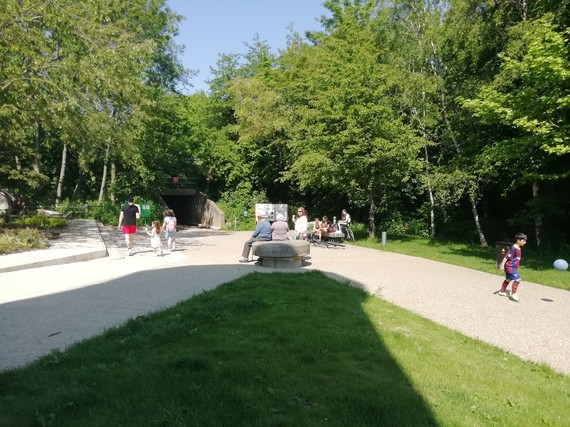 Families and friends enjoying the sunshine in the recently laid-out plaza area near to the mill and the underpass entrance to the Country Park.
The Mill Finally Opens!!
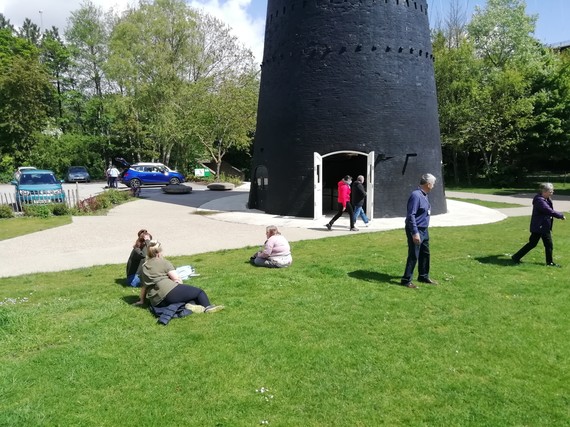 Vistors enjoying the sunshine and sights on the mill's first open day on Tuesday 18 May.
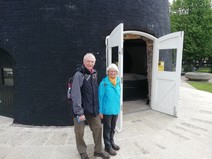
After 2 and half years of renovation work and delays, Hessle Whiting Mill opened its doors to visitors on Tuesday 18 May. Since that date our Heritage Officer and volunteers have welcomed almost 300 visitors to the mill. Forming part of the Country Park's Chalk Walk heritage trail, the mill is open every Tuesday and Friday 10am and 4pm (closed for the lunch 12-1). We hope to increase our number of open days as Covid restrictions are lifted and more volunteers are recruited. Throughout the summer we plan to run events in and around the mill, providing that restrictions allow. We look forward to meeting you on site!
Follow all updates from the mill and the Country Park on our website: quarrytocountrypark.co.uk
And our Facebook page: facebook.com/HumberBridgeCP
|
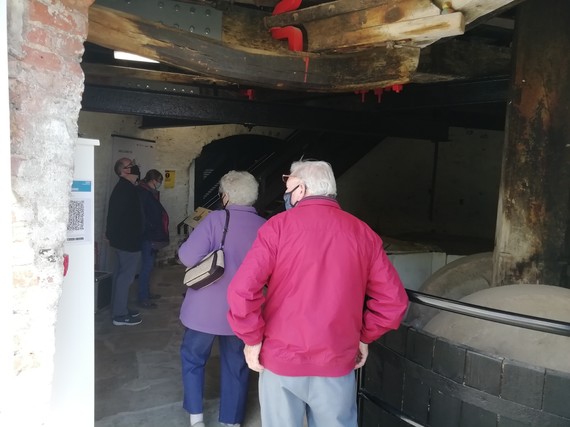 Some of the nearly 300 visitors which have been welcomed to the newly opened whiting mill in recent weeks.
From the Newspapers: 'Proposed Bridge Across the Humber'
by Sally George, Quarry to Country Park Volunteer
The first edition of the new 'From the Newspapers' feature is a Victorian proposal for a rail bridge across the River Humber, which featured in The Hull Packet 4 August 1865:
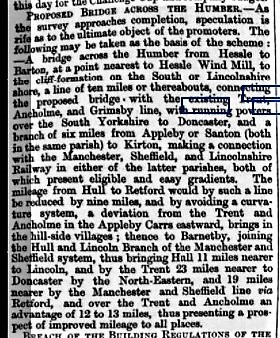
"As the survey approaches completion, speculation is rife as to the ultimate object of the promoters. The following may be taken as the basis of the scheme. - A bridge across the Humber from Hessle to Barton, at a point nearest to Hessle Wind Mill, to the cliff-formation on the South or Lincolnshire shore, a line of ten miles or thereabouts, connecting the proposed bridge with the existing Trent, Ancholme, and Grimsby line, with running powers over the South Yorkshire to Doncaster, and a branch of six miles from Appleby or Santon (both in the same parish) to Kirton, making a connection with the Manchester, Sheffield, and Lincolnshire Railway in either of the latter parishes, both of which present eligible and easy gradients. The mileage from Hull to Retford would by such a line be reduced by nine miles, and by avoiding a curvature systems, a deviation from the Trent and Ancholme in the Appleby Carrs eastward, brings in the hill-side villages; thence to Barnetby, joining the Hull and Lincoln, and by the Trent and Ancholme an advantage of 12 to 13 miles, thus presenting a prospect of improved mileage to all places."
|
 A locomotive built for theTrent, Ancholme, and Grimsby line. The proposed bridge was to connect the north bank of the Humber to this existing line.
Hessle Mill in 1981
 Photograph of the derelict mill tower in 1981. Image by Gordon Meredith.
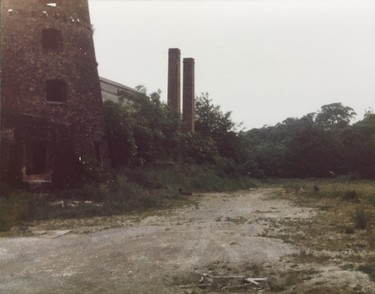
This fantastic pair of photographs taken by one-time Hessle resident, Gordon Meredith, show the mill looking very different in the early 1980s.
The building with the two chimneys to the right was built in 1939 and housed a modern whiting plant. It stood on what is now the car park to the rear of the mill.
The mill's sails and cap had been removed in 1925. Thereafter the mill's crushing stones in the base of the tower were powered by gas, diesel and later electric. Consequently, the upper floors of the mill's tower increasingly fell into dereliction over the following 55 years.
The opening of the Humber Bridge in the same year as these photographs were taken, brought a new focus to the mill as a unique example of an early 19th century whiting mill. It was bought by Beverley Borough Council in 1982. The mill's tower underwent extensive restoration and much of the internal machinery was remounted. The mill was then opened to the public as a heritage feature on the foreshore until it closed its doors to the public in 1996.
Did you visit the mill when it was previously opened to the public between 1984 and 1996? What can you remember about it? Do you have any photographs?
If so, we would love to hear from you by emailing alex.ombler@eastriding.gov.uk.
|
Feathered Friends: Buzzards in the Country Park
 In recent months visitors to the Country Park have been treated to the sight of a pair of common Buzzards. These magnificent birds of prey can often be seen soaring above the large pond and it is believed the birds are nesting in or around the Country Park.
In the spring, male buzzards perform a 'roller coaster' display, soaring up high and then swooping down over and over again to attract a mate. Once paired, buzzards construct their bulky nest in the fork of a large tree, often near to a wood. The female will lay between two and four eggs, which take just over a month to hatch.
Buzzards eat small birds, mammals and carrion, but will also eat large insects and earthworms when prey is in short supply. Until recently, these birds were only found in the north and west of the country due to severe population declines. Over the last couple of decades, however, they have been doing very well and can now be found almost everywhere in the UK.
When you're next in the Country Park listen out for the birds' cat-like,'kee-yaaa' calls as they soar above the ponds, meadows and woodlands.
Meet the Team: Alex

I joined the Quarry to Country Park project as the Heritage Officer in January 2019. As my research interests are in industrial and maritime history, I was delighted to take part in creating The Chalk Walk heritage trail and help reveal the hidden natural, industrial and social heritage of the Humber Bridge Country Park.
In my 2 and a half years on the project I have very much enjoyed completing research on the history of the mill in the East Riding Archives. It has also been great to work with the volunteer team and meet visitors at the mill. I love to hear people's fascinating memories of Little Switzerland and it's fantastic to see grandparents and parents bringing their little ones to the Country Park, where they themselves once played.
|
The Country Park is a place I have a visited since I was a child. I can even remember gathering with the St Anthony's Beavers at the Country Park in about 1987 prior to embarking on a sponsored walk across the Humber Bridge! |
|
 |
From the Archives: Thomas Sheppard, The Hessle Chalk Quarries (1898)

The book Hessle Chalk Quarries (1898) by Thomas Shepperd (Archive Ref: YE-553), which can be found in the collections of East Riding Archives, offers a fascinating geological history of the Country Park. The book covers the formation of the Chalk Wolds during the Cretaceous period around 80 million years ago. It also details the fossilised remains of marine creatures which have been found on the site of what is now the Country Park.
This is just one of the many publications written by Thomas Sheppard, who, at one time, was a well-known and popular character in Hull. Sheppard (pictured below) was born on the southern shore of the Humber in South Ferriby (North Lincolnshire) on 2 October 1876. He was the eldest of a family of ten.
|
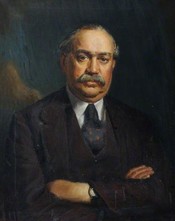
In January 1901 (aged 24) he was appointed as the first Curator of the Hull Municipal Museum established with the Subscription Library in the Royal Institution in Albion Street (sadly destroyed during the Second World War on 24 June 1943 and demolished in 1947). The newly formed museum, based mainly on the Hull Literary & Philosophical Society collections, was re-opened on 2 June 1902 after 18 months of refurbishment under Thomas Sheppard's direction; he immediately abolished admission charges, so thereafter there were never less than 2000 visitors per week. Over the years he was responsible for establishing further seven museums in Hull.
|
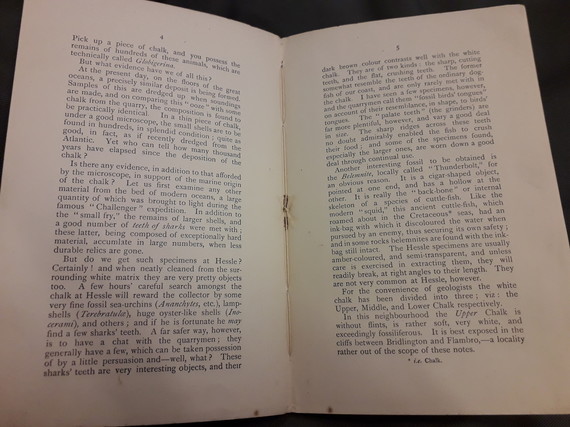 Hessle Chalk Quarries (1898) byThomas Shepperd (Archive Ref: YE-553).
Around 1926 Sheppard was made Director of Museums and Curator of City Hall Art Gallery, but he lost the latter title through reorganisation soon after. He reluctantly retired (at the age limit) in 1941. Sheppard was also a popular guide on geological excursions, it was said that he was a pleasant companion in the field, and always ready to encourage and assist young geologists. In later years he was described as a portly and jovial man, with a great love of cigars. Thomas died on 18 February 1945.
|